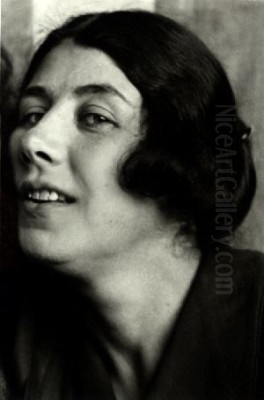
Lyubov Sergeyevna Popova (1889-1924) stands as one of the most dynamic and influential figures of the Russian avant-garde, a multifaceted artist whose tragically short career nevertheless left an indelible mark on the trajectory of modern art. A painter, designer, and theorist, Popova navigated and contributed significantly to the whirlwind of artistic innovation that characterized early 20th-century Russia. Her work, evolving rapidly through various styles, consistently demonstrated a profound intellectual engagement with form, color, and space, and a fervent belief in art's transformative potential in society. This exploration delves into her life, her artistic evolution, her key contributions, and her enduring legacy.
Early Life and Artistic Awakening
Born on April 24, 1889, near Moscow into a prosperous and cultured family, Lyubov Popova was exposed to art and music from a young age. Her father, Sergei Maximovich Popov, was a wealthy textile merchant, and her mother, Lyubov Vasilievna Zubova, came from a highly educated family. This environment fostered her intellectual curiosity and artistic inclinations. Her parents were passionate music lovers, which likely contributed to her later sensitivity to rhythm and dynamism in her visual art.
Popova's formal art education began in her youth. She initially studied under the painter Stanislav Zhukovsky, a respected landscape artist, from 1907. In 1908, she entered the private studios of Konstantin Yuon and Ivan Dudin in Moscow, where she received a solid academic grounding. These early teachers provided her with technical skills, but Popova's restless intellect soon sought more radical forms of expression. She was part of a generation eager to break from academic constraints and explore new artistic languages.
Her early artistic explorations were also fueled by travel. Journeys through ancient Russian towns like Pskov and Novgorod in 1909 and 1910 exposed her to the spiritual power and formal conventions of Russian icon painting. The flat perspectives, bold colors, and linear emphasis of icons would resonate in her later, more abstract work, providing a distinctly Russian foundation to her modernist pursuits.
Formative Journeys: Italy and the Embrace of Modernism
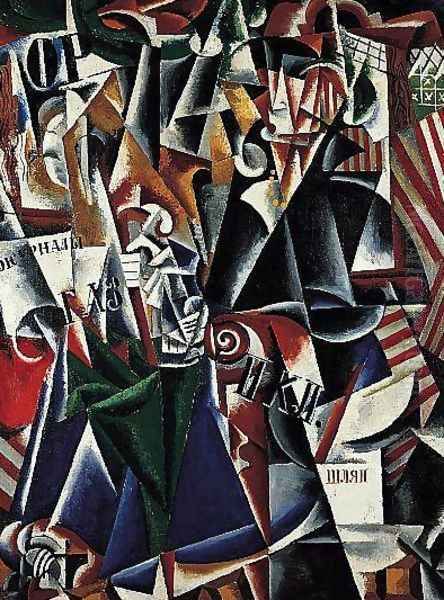
A pivotal period in Popova's development involved extensive travel and study in Europe. Between 1909 and 1912, she visited Italy, where she was deeply impressed by the monumental frescoes of Giotto and the works of other Early Renaissance masters. The structural clarity and compositional strength of these 14th and 15th-century Italian painters captivated her, offering lessons in spatial organization and the expressive power of form that transcended mere representation. This immersion in historical art provided a rich counterpoint to the burgeoning modernist movements she would soon encounter.
In 1912, Popova, along with her close friend and fellow artist Nadezhda Udaltsova, traveled to Paris, then the undisputed epicenter of the artistic avant-garde. This experience was transformative. They studied at the Académie de la Palette under Cubist painters Henri Le Fauconnier and Jean Metzinger, and also frequented the studio of André Dunoyer de Segonzac. In Paris, Popova absorbed the principles of Cubism firsthand, engaging with its revolutionary deconstruction of form and its exploration of multiple perspectives. She encountered the works of Pablo Picasso and Georges Braque, whose innovations were reshaping the very definition of painting.
During her time in Paris (1912-1913) and a subsequent trip in 1914 with the sculptor Vera Mukhina, Popova also became acquainted with Futurism, the Italian movement championed by Filippo Tommaso Marinetti, which celebrated dynamism, speed, and the machine age. The Futurist emphasis on motion and energy would significantly impact her developing style. She also interacted with sculptors like Alexander Archipenko and Ossip Zadkin, whose three-dimensional explorations of Cubist principles further expanded her artistic vocabulary.
Cubo-Futurism and the Russian Synthesis
Returning to Russia, Popova brought with her a wealth of new ideas and a determination to forge a distinctly modern Russian art. She began working in the studio of Vladimir Tatlin, known as "The Tower," a crucible for avant-garde experimentation in Moscow. Here, she collaborated with artists like Tatlin himself, Ivan Aksenov, Kirill Zdanevich, and Aleksei Grishchenko. This period, roughly from 1913 to 1915, saw Popova develop her own powerful variant of Cubo-Futurism.
Cubo-Futurism, a uniquely Russian synthesis, merged the formal innovations of French Cubism with the dynamism and thematic concerns of Italian Futurism, often infused with elements of Russian folk art and icon painting. Popova's works from this period, such as Portrait of a Philosopher (1915) and The Traveler (1915), demonstrate this fusion. They feature fragmented forms, intersecting planes, and a sense of energetic movement, yet often retain a degree of legibility and a strong compositional structure. She was less interested in the purely analytical aspects of Cubism and more drawn to its potential for creating dynamic, architectonic compositions.
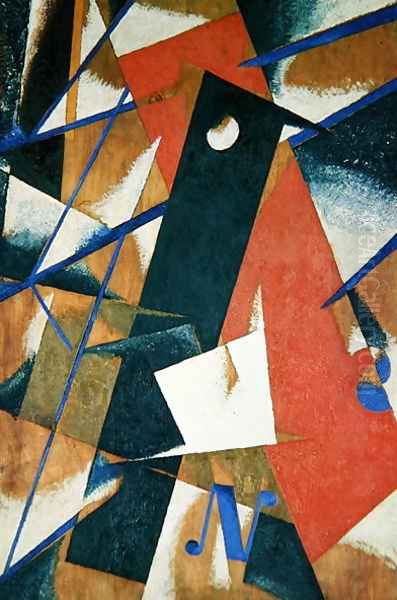
Popova actively participated in key avant-garde exhibitions, including the "Jack of Diamonds" (or "Knave of Diamonds" - Bubnovy Valet) exhibitions, which featured artists like Mikhail Larionov, Natalia Goncharova, and Kazimir Malevich. These exhibitions were crucial for disseminating new artistic ideas and challenging conservative tastes. Her early Cubo-Futurist works were characterized by a robust handling of paint, strong lines, and an increasingly abstract approach to subject matter.
Painterly Architectonics: Towards Pure Abstraction
By 1916, Popova's art was moving decisively towards non-objective painting. This shift was partly influenced by her association with Kazimir Malevich and his Suprematist movement. In 1916, she joined the "Supremus" group, founded by Malevich, which included other prominent artists like Olga Rozanova, Nadezhda Udaltsova, Aleksandra Ekster, and Ivan Kliun. While influenced by Suprematism's emphasis on pure geometric form and spiritual abstraction, Popova developed her own distinct approach.
This culminated in her series of works titled Painterly Architectonics, created between 1916 and 1918. These powerful abstract compositions are characterized by overlapping, dynamic geometric planes, often rendered in rich, vibrant colors. Unlike Malevich's more static and transcendent Suprematist compositions, Popova's Painterly Architectonics convey a sense of energy, construction, and spatial tension. The term "architectonics" itself suggests a concern with structure and building, reflecting her interest in creating a new visual language based on fundamental principles of form and color. Works like Painterly Architectonic (Still Life: Instruments) (1915, though titled later, it shows the transition) and later, more purely abstract pieces from 1917-1918, exemplify this phase. These paintings are not depictions of existing architecture but are, in themselves, constructed visual realities.
Her exploration of abstraction was rigorous and intellectual. She sought to understand the inherent properties of color and form and their ability to create dynamic relationships on the canvas. The Painterly Architectonics series represents a high point in her easel painting, demonstrating a sophisticated command of abstract language and a unique ability to imbue geometric forms with a sense of life and movement.
Constructivism: Art into Life
The October Revolution of 1917 profoundly impacted the Russian avant-garde, including Popova. Many artists, filled with revolutionary fervor, sought to align their work with the goals of the new socialist society. This led to the rise of Constructivism, a movement that rejected "art for art's sake" and advocated for art as a tool for social construction and practical application. Popova became a leading figure in this movement.
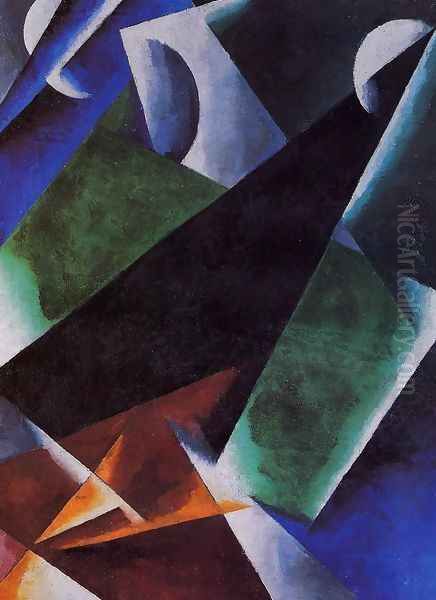
Around 1921, Popova, along with Alexander Rodchenko, Varvara Stepanova, Aleksandra Ekster, and Alexander Vesnin, made a decisive break from easel painting, which they increasingly viewed as a bourgeois pursuit. They declared their commitment to "production art," aiming to apply artistic principles to the design of everyday objects, textiles, clothing, stage sets, and propaganda. Popova formally renounced painting at the landmark "5x5=25" exhibition in Moscow in 1921, where she, Rodchenko, Stepanova, Vesnin, and Ekster each showed five works. Her contribution included abstract line constructions, signaling her move towards a more utilitarian and materially-focused art.
She became an active member of INKhUK (Institute of Artistic Culture) in Moscow, a key theoretical center for Constructivism. At INKhUK, debates raged about the role of the artist in the new society. Popova contributed to these discussions, drafting reports on art teaching and advocating for an art that was integrated into the fabric of daily life. She believed that the artist should be an "artist-engineer," using their skills to shape the new environment.
A Multifaceted Talent: Design for a New World
Popova's transition to production art unleashed her remarkable versatility. She threw herself into various design fields with characteristic energy and innovation.
Stage Design: Popova made significant contributions to avant-garde theater. Her most famous work in this field was the set and costume design for Vsevolod Meyerhold's 1922 production of Fernand Crommelynck's The Magnanimous Cuckold. Her set was a dynamic, multi-levelled "machine for acting," an abstract construction of wheels, platforms, and moving parts that eschewed illusionistic scenery in favor of a functional apparatus that facilitated the actors' biomechanical movements. This design became an icon of Constructivist theater. She also designed for other productions, such as Earth in Turmoil (Zemlya dybom) by Sergei Tretyakov and Meyerhold in 1923, for which she designed political slogans and dynamic visual elements.
Textile and Clothing Design: From 1923 to 1924, Popova, alongside Varvara Stepanova, worked as a textile designer at the First State Textile Factory in Moscow. They aimed to revolutionize textile design, moving away from traditional floral patterns towards bold geometric motifs and abstract compositions suitable for mass production. Her designs featured dynamic arrangements of circles, triangles, lines, and chevrons in vibrant, often primary, colors. These designs were intended to be modern, functional, and accessible, reflecting the egalitarian ideals of the new society. She also designed clothing, emphasizing practicality and a unisex aesthetic.
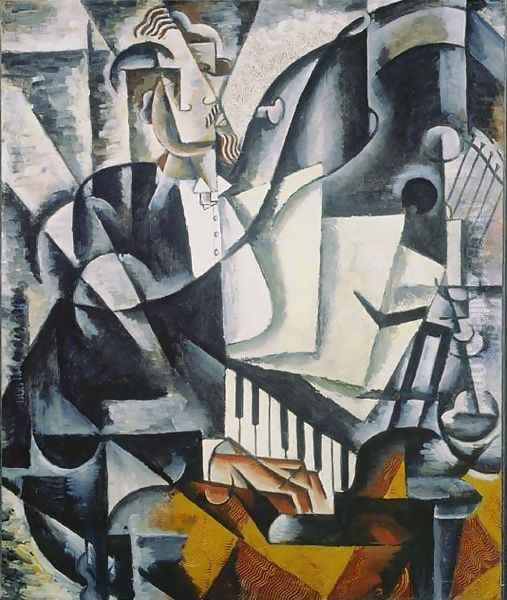
Graphic Design and Typography: Popova also applied her Constructivist principles to graphic design, creating posters and book designs. Her work in this area utilized bold typography, geometric layouts, and photomontage, techniques favored by Constructivists like Rodchenko and El Lissitzky for their directness and communicative power. She designed book covers and contributed to journals, always seeking to integrate form and content in a dynamic and impactful way.
Throughout her Constructivist phase, Popova maintained a strong sense of color and rhythm, qualities that had characterized her paintings. Her designs were never merely utilitarian; they possessed a powerful aesthetic force, demonstrating that functional objects could also be visually exciting and innovative. She also taught color theory at VKhUTEMAS (Higher State Artistic and Technical Workshops), the groundbreaking Soviet art and design school, alongside other leading avant-garde figures like Wassily Kandinsky, Rodchenko, and Tatlin.
Collaborations and Artistic Circles
Popova's career was deeply intertwined with the vibrant artistic community of her time. Her collaboration with Nadezhda Udaltsova was foundational, from their early studies to their Parisian adventures and their shared involvement in avant-garde exhibitions. Her work in Tatlin's "Tower" studio placed her at the heart of early Cubo-Futurist developments.
Her participation in the "Supremus" group connected her with Malevich and his circle, though she always maintained her artistic independence. The shift to Constructivism saw her working closely with Alexander Rodchenko and Varvara Stepanova, forming a powerful triumvirate that pushed the boundaries of production art. Her partnership with Alexander Vesnin, with whom she briefly ran a color studio, was also significant.
These collaborations were not just about shared projects but also about intense theoretical debate and mutual support. The Russian avant-garde was characterized by a ferment of ideas, manifestos, and group formations, and Popova was an active and respected participant in these dialogues. She was known for her intelligence, her strong will, and her unwavering commitment to her artistic principles.
Personal Life and Tragic End
Popova's personal life was marked by both joy and profound tragedy. In 1918, she married the art historian Boris Nikolaevich von Eding, and they had a son. However, von Eding died of typhoid fever in 1919, leaving Popova a young widow with a child. This personal loss occurred during a period of intense artistic activity and societal upheaval.
Despite the hardships of the post-revolutionary years, including civil war and economic scarcity, Popova continued her work with immense dedication. She poured her energy into her art and her teaching, driven by a belief in the transformative power of design.
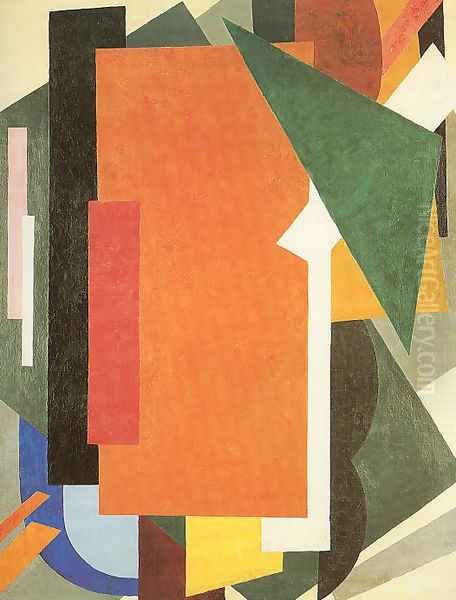
Tragically, Lyubov Popova's life and brilliant career were cut short. In May 1924, her young son died of scarlet fever. Just a few days later, on May 25, 1924, Popova herself succumbed to the same disease. She was only 35 years old. Her death was a profound loss to the Russian avant-garde and to the world of modern art. A posthumous exhibition of her work was organized in Moscow in December 1924, a testament to her significant contributions. Her friends and colleagues mourned her as an "Artist-Constructor," a title that aptly summarized her commitment to building a new art for a new society.
Legacy and Enduring Influence
Despite her short life, Lyubov Popova's impact was substantial. She was a pioneer in the development of abstract art and a key figure in the Russian avant-garde's most innovative movements: Cubo-Futurism, Suprematism, and particularly Constructivism. Her Painterly Architectonics series stands as a major achievement in non-objective painting, demonstrating a unique fusion of dynamism and structural rigor.
Her work in stage, textile, and graphic design exemplified the Constructivist ideal of integrating art into everyday life. Her designs for The Magnanimous Cuckold remain a landmark in modern theater history, and her textile patterns are celebrated for their bold modernity and have influenced designers for generations. Artists like Sophie Taeuber-Arp and Sonia Delaunay, working in similar interdisciplinary ways in Western Europe, shared some of Popova's concerns with bridging the gap between fine art and applied design.
Popova's legacy also lies in her role as a woman artist who achieved prominence in a male-dominated field. She, along with contemporaries like Natalia Goncharova, Olga Rozanova, Varvara Stepanova, and Aleksandra Ekster, collectively known as the "Amazons of the Avant-Garde," challenged traditional gender roles and redefined the possibilities for women in art.
Her works are held in major museum collections worldwide, including the State Tretyakov Gallery in Moscow, the State Russian Museum in St. Petersburg, the Museum of Modern Art (MoMA) in New York, and the Tate Modern in London. Exhibitions of her work continue to draw attention to her innovative spirit and her significant contributions to 20th-century art.
Lyubov Popova's art remains a powerful testament to a period of extraordinary artistic ferment and social idealism. Her journey from figurative painting through Cubo-Futurism and Suprematism to the utilitarian principles of Constructivism reflects a relentless quest for new forms of expression and a profound belief in art's capacity to shape and reflect a changing world. Her dynamic compositions, whether on canvas, fabric, or the stage, continue to inspire with their energy, intelligence, and visionary power.